Free fly tying
{{start}}
{{end}}

{{+1}}Dry fly wings{{-1}}
{{start}}
Wings on flies have two main purposes.The first is to help the fly look like the natural and the second is to help with the floating capability of the fly. Dry fly hackle wings satisfy both of those criteria.{{end}}

{{+1}}Articulated popper head{{-1}}
{{start}}
Poppers are a bit harder to cast than a normal fly because of the wind resistance but if you slow your cast down a little I'm sure you'll soon get the hang of it. Once you do you have another tool in your arsenal which is useful in three diverse situations:{{end}}
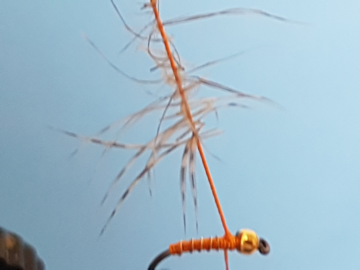
{{+1}}Hackle – fabricate a hackle{{-1}}
{{start}}
Select a hackle that has barbules that are around the length of the shank of the hook. Opps! "the smallest hackle I have is far to big for this fly ... I'll have to make a hackle"{{end}}
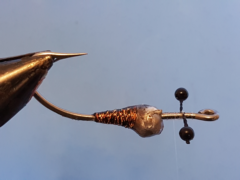
{{+1}}Eyes – Plastic bead chain{{-1}}
{{start}}
Whilst there are many ways of adding eyes to a fly one easy way to add a little more realism to a fly is to include a set of eyes made from a length of plastic bead chain. Most recipes use the term "figure of eight wraps of thread" when describing how to tie in burnt monofilament eyes{{end}}
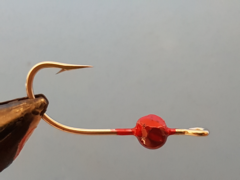
{{+1}}Adding a lead split shot to the hook shank{{-1}}
{{start}}
I have several flies, particularly in my saltwater range, which include a lead shot to what is the the bottom of the hook shank when the fly is intended to swim hook point up.{{end}}
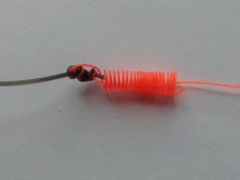
{{+1}}Coils or springs as indicators for nymphing rivers{{-1}}
{{start}}
Outside the competition scene there are no rules about adding floating or sinking devices to leaders or fly lines as visible indicators for use when nymphing rivers. Consequently all sorts of floating indicators in the form of bits of foam, plastic, wool etc. are added to nymphing fly lines or leaders so that fly fishers can see when they have had an enquiry or take.
On the competition fly fishing scene it has been a different story and the use of indicators, for a long time now, has been limited by rules that, amongst other things, dictate that "neither sinking nor floating devices may be added to fly lines or leaders".
You only have to go back a few years, to a time when if you wanted to have an indicator when nymphing a river in a competition, you would use a dry fly and fish a nymph under that.
Over the last few years indicator nymphing on the competition scene has gone through quite a revolution.
The first break through came with the French long leader form of fly fishing. In that system a short section of coloured braid (the type you would use as backing behind a fly line) was initially included in the leader as an indicator. The fly line right down and to the end of that coloured braid was treated with floatant providing the angler with an indicator that was very visible and quite buoyant.
The reasons for changes to the 'Fips Mouche' competition fly fishing rules that govern competition fly fishing internationally are often hard to understand and for reasons that have never been adequately explained to me the governing body, all most as quick as it became popular, made the use of braided material as an indicator within a leader illegal.
The next development was coloured monofiliment tippet material and whilst not as buoyant or as viable as the coloured braid the coloured monofiliment has continued to be an accepted material for the use as indicators in river nymphing set ups. Quite a few different ways of using coloured monofiliment as an indicator have been contrived and of course a few have been ruled illegal by "the fun police".
Theses days the most common form of coloured indicator in a river leader set up is the inclusion of a length of monofilament within 1 to 3 meters of the point fly.
The current limitations imposed by Fips Mouche Rules and Managers Meetings limitations as I understand them are:
- Rule 27.2 provides "Leaders may be knotted or knotless, and continuously tapered down or level." This means that as you add each section to your leader it must be thinner than the section above it ... so choose the thickness of your coloured monofiliment indicator line carefully.
- Rule 26.4 and 27.3 respectively provide that neither sinking nor floating devices may be added to fly lines or leaders. Interestingly the governing body, Fips Mouche, has remained relatively silent on the use of coloured monofiliment in leaders and instead has allowed "Captains Meetings" at various World Fly Fishing Championships to limit how the coloured monofiliment can be used.
- As the use of coloured monofiliment developed Captains Meetings have resolved that the minimum length of any component within a leader has to be 30cm un-streached. This was brought in as a Captains Meeting rule to avoid the use of coils in the leader itself. What was happening was that innovative competitors were creating a coil much in the same way as described below but it was in the leader itself not the tag as as in my leader set up. These inline coils were great indicators but if made to long made the strike less effective so typically the in-leader coils were much less than 30cm long un-stretched.
- The next step was that rather than the in line coil it became common practice to leave the tag ends of the coloured monofiliment section reasonably long and untrimmed when the coloured monofiliment was tied in. These long untrimmed tags add to the visibility of the indicator. This process has passed scrutiny of Managers meetings of a couple of World Fly Fishing Championships now and is how many competition fly fishers present their coloured indicator today.
- The step below is a logical next step that I have made and at this stage, to the best of my knowledge, complies with current Fips Mouche and Managers Meetings rules and is the indicator set up I use in my longer leader river nymphing set up. Whilst I tested it with my controllers at the 2014 Fly Fish Australia National Fly Fishing Championships it will be interesting to see if it will be tested and pass the scrutiny of the "fun police" (Fips Mouche or Managers meetings).
In any case, I am still keen to share how I use coils in my river nymphing set up with you because, to the best of my knowledge, it is currently a great form of coloured indicator for competition fly fishing and of course a great ongoing leader indicator for recreational river nymphing.
Materials
| Leader | Coloured indicator monofiliment | Leader/tippet material to use as sacrificial butt section below the coloured indicator | Tippet material | You will also need |
|---|---|---|---|---|
| The leader I have settle on for my longer leader river nymphing set up has a butt end that is 0.57mm thick and business end that is 0.35mm thick. The end of the fly line that I use 0.60mm thick so the 0.57mm butt end of the leader connects to that neatly with a 8 turn nail knot and the business end of the leader is .35 thick which is ideal for the balance of the leader set up as described below. | I use Cortland bi-colour indicator mono which is 0.33mm thick and a comfortable step down from my leader. | My preference in leader/tippet materials for indicator nymphing is Shogun and my sacrificial section below the coloured indicator is 0.16 thick and complies with the step down rule. | My tippet is also Shogun monofiliment and I use the thinnest below 0.16 that I can get away with. Where I can that is 0.10 thick and just 1.8kg breaking strain. | A ruler, sticky tape and a couple of round tooth picks |
Process
| J |
|
 |
|---|
{{end}}
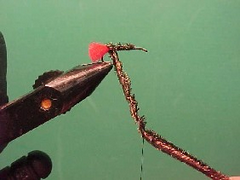
{{+1}}Roping peacock herl{{-1}}
{{start}}
This is my favorite way of forming bodies on flies. peacock herl is a wonderfully organic material and takes on a very live aura when used as part of a fly. Try this technique on dry flies and wet flies ... you will be surprised how good it is.{{end}}
{{+1}}Understanding hooks{{-1}}
{{start}}
There is more to a hook than just a piece of bent wire with a sharp point.{{end}}
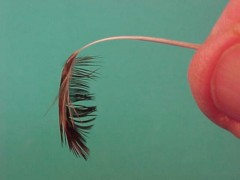
{{+1}}Bending hackles{{-1}}
{{start}}
This skill explains how to modify feathers so that when you tie them in their tips do not flare away from where they are intended to be.{{end}}
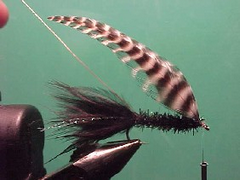
{{+1}}Woolly bugger hackles{{-1}}
{{start}}
Hackles are added to woolly buggers and woolly bugger variants for a couple of reasons. Firstly they add what may well be representative of legs on what ever the woolly bugger is tied to represent. The second reason to add movement to the fly. In most cases it's varying degrees of both ... what ever the reason for the hackle or hackles they are an intrinsic part of perhaps the quintessential wet trout fly.{{end}}






















